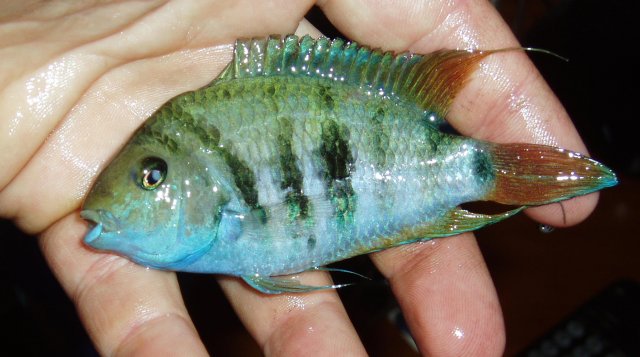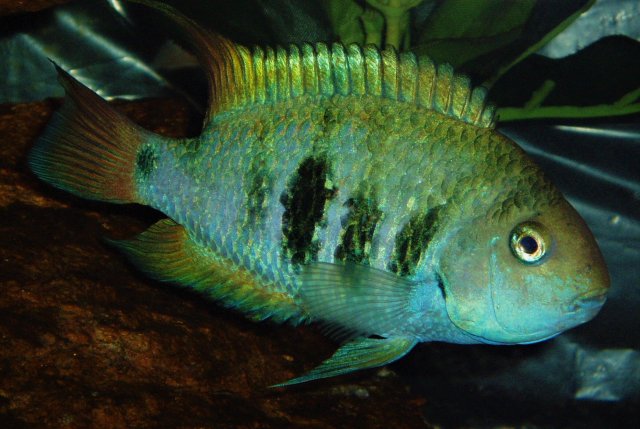Hey all. good stuff in here. Glad I was pointed to the topic. Happy to address a few comments in the topic.
so, before i get to the hrp topic ill point out to Toiletcar:
I list as Vieja melanura as Vieja melanura 'var. synspila' only to indicate these are the redheaded colored fish versus the mostly yellow fish but, never, ever, have I listed them as solely Vieja syspila. wrong vendor

... I personally wouldn't even use 'var. synspila' at all if it weren't for that fact that I receive half a dozen emails a day asking if they are the redheaded fish or the yellow fish EVERY DAY because other vendors still call them Vieja synspilum.
Yes. This.
Being completely involved in the industry includes me having a relationship with the scientific community, and the collectors. which far supersedes my time as being a vendor. These relationships help keep me on top of the 'what's going on' stuff that many of the large retailers are not involved in or do not have access to the contacts. I mean who else here as personal access to people like Jeff Rapps(Aquatic Biologist by education) Juan Miguel, as well as others, who are all a text message away from me? I am able to stay somewhat on top of what's going on because of this. I listed my wild Rio Magdalena Kronoheros umbriferus as Kronohers cf. umbriferus 'Rio Magdalena' a few weeks ago and similar questions where asked as to why I was the only vendor calling them as so. The answer was because I was the only vendor that knew they are going to be redescribed and named. The umbie from Panama will likely remain the K. umbriferus while the most popular umbie of all the blue rio mag. Colombian counterpart and the others will be renamed. I know this because I have a close relationship with those doing the field work.
So back to the hrp. First, in all of Honduras and even parts of Nicaragua ALL convict type fish are called 'red points'. that is a common local name.
As far as how I named them on my stock list. The link Duanes provided pretty much is the answer. DNA says they are the same. They have not formally been named that yet so the use of cf. was used. You will also find that siquia is no longer. A. siquia is also now nigrofasciata. DNA says they do not have enough difference to separate them. So I have to go with the science. I have kept and maintained the original group of hrp sent to me by Jeff Rapps that were being distributed in the mid 90s from Rusty Wessels original group(that he still maintains!). If you were to ask me and I didn't know the work being done I would tell you myself without a doubt that no way are they the same fish, they have so many differences. but, I would be wrong.
Rio Danli population... There is no Rio Danli. The use of 'Rio' Danli is incorrect. The real Honduran red point as we know it is from the Rio Los Amadros population that runs next to the city of Danli. The Rio Mongo fish that some have also called the red point is also genetically the same fish and in Honduras is called 'red point ' as well. However, even I agree it looks different. but science..
All of that said I would still not recommend mixing same fish from different locations.
20+ years ago no body cared about exact specific locations. A convict was a convict, a red devil was a red devil, etc., etc., and some were just cooler looking than others. As we got smarter about mixing similar 'looking' fish and science got better the need to know exact locations became more common. Even to this day I am one of the very few vendors that lists fish with an attached exact locale. Some give a general location like Peru, or Colombia but not many commercial vendors give an exact locale. Heck some have fish listed from locales they donmt even exist in.. Likely because the exporters may not know or the fisherman providing the export co. does not want to give up his fishing spot. TUIC has had 26 years of personal communication with the local fisherman and the export companies so I have a very good relationship and they know I will not complete an import without the known location. Often I (and Jeff before me) request collections from very specific regions. I send fish to multiple people in private labs and to multiple universities that do scientific research on them so knowing exact information is important for the work they do. I list fish with a filial number up to F3. Anything after that I list just as 'CB' for captive bred even if I have a proven original collection locale to use. I wont be that guy that says f6 lol. Anything with a unknown provenance or even if from fish caught in from non-native location I use CB. Calling a fish F1(or whatever gen.) from a non-native population is misleading at best. I mean I could go to Florida and catch 'wild' central & south Americans or got to Mexico and catch wild African fish all day..
I do my best to stay on top of the science part of the industry so that I can provide my clients with the most up-to-date and most accurate information available. I don't use common (US) names, heck I don't even know half of them that are used these days. I hate the use of 'grades'. I know that at least one vendor refers to his wild fish in grades. Likely because they do not know the location or worse cannot ID the species correctly. You guys will NEVER, EVER get that from me. So, just because I am the only one using a name in a specific way certainly does not mean I am wrong. maybe its because I am giving you all the most up to date information.
For anyone looking for the most up to date info I HIGHLY recommend getting the paid subscription to The Cichlidroom Companion. I know Juan Miguel well and we've had a relationship for a number of decades and we communicate regularly(actually recently spoke about these fish in question!). He works his a** off to provide the best information. He is in regular contact with all of the best of the best. The subscription is beyond well worth its price.




